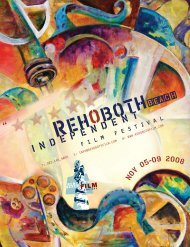nov 10-14 2010 - Rehoboth Beach Film Society
nov 10-14 2010 - Rehoboth Beach Film Society
nov 10-14 2010 - Rehoboth Beach Film Society
You also want an ePaper? Increase the reach of your titles
YUMPU automatically turns print PDFs into web optimized ePapers that Google loves.
CounTRy spoTlIghT: IndIa<br />
80<br />
CounTRy spoTlIghT: IndIa<br />
by Ramsey Furse<br />
each year country Spotlight showcases the art of filmmaking from a specific region by<br />
presenting a selection of films that expose audiences to the culture and lives of people in<br />
distant lands.<br />
this experience is further enhanced in the big tent where festival attendees can participate<br />
in a variety of cultural activities that further acquaint us with the traditions of the featured<br />
country (See live in the lounge, pages 92-93). country Spotlight also engages industry<br />
professionals to lead a seminar so we may learn the differences and similarities of the film<br />
industry around the globe.<br />
although countries may have cultural, religious, and political differences, country Spotlight<br />
reveals the universality of the human experience. be sure to include country Spotlight<br />
activities in your Festival schedule. you will be glad that you did!<br />
this year we are pleased to present country Spotlight: india<br />
While the attention of most international media is focused on<br />
the palm tree laden streets of Hollywood when it comes time<br />
to report on the film business, it is the streets of Bollywood<br />
which are some of the most vibrant in the industry. For several<br />
decades now the film industry of India, has been the most<br />
prolific one in the world, and one of the most diverse ones as<br />
well. In 2009, a total of 1,288 feature films plus 200 shorts were<br />
made in India.<br />
The term “Bollywood” is often used incorrectly, as it refers just<br />
to the Hindi filmmaking center of Mumbai (formerly Bombay),<br />
instead of to the entire Indian film business. India is a nation of<br />
many different languages which is reflected in the 24 different<br />
languages used in feature films released in 2009 alone.<br />
The most recognized director in Indian history, is Satyajit Ray.<br />
His best known films are The Apu Trilogy, a series of films about<br />
a young Bengali boy growing up in the early decades of the<br />
1900’s. Of these three films, Panther Panchali, the first one in<br />
the series, is the one which established Ray’s international<br />
reputation. These films would be at the forefront of “parallel<br />
cinema,” also known as the “Indian New Wave,” one of the<br />
preeminent movements in art film in Indian history. Ray would<br />
go on to make many more critically acclaimed films throughout<br />
his lifetime, and would receive an Honorary Oscar in 1992, just<br />
weeks before his death.<br />
While Ray’s more naturalistic style might have been the best<br />
example of Indian cinema, the common type of films shown<br />
in modern-day India, are elaborate action and drama filled<br />
epics, which frequently feature several grand song and dance<br />
numbers, regardless of the genre of the rest of the film. This<br />
blending of numerous, and in theory, disparate elements from<br />
different genres into a single film is called a “masala film” and<br />
is very popular in India.<br />
All of this might not have been possible however, without the<br />
work of Dadasaheb Phalke, known as the Father of Indian<br />
Cinema. Originally trained in photography, Phalke was so<br />
enamored after a 19<strong>10</strong> showing of the film The Life of Christ that<br />
he became determined to create a local film business in India,<br />
which would focus on Indian values and folklore. After going<br />
overseas to train in England, he would return and make his<br />
first film Raja Harishchandra, and one that would prove to be the<br />
beginning of a string of successes. Throughout the rest of the<br />
decade his films would become more popular and critically<br />
acclaimed, while at the same time staying true to the Indian<br />
culture that Phalke sought to represent. Indian gods and<br />
goddesses were portrayed in his films, and Indians themselves<br />
would act out the characters. His films were truly a national<br />
affair, and while he would fall out of favor after the rise of<br />
talkies, his early attempts at creating a national style of film<br />
would give birth to a gigantic legacy of film.<br />
The Indian films that make up the spotlight contain a great<br />
balance of big blockbusters and powerful and sophisticated<br />
independent cinema, which is experiencing a surge in the type<br />
of films being made in the country.



